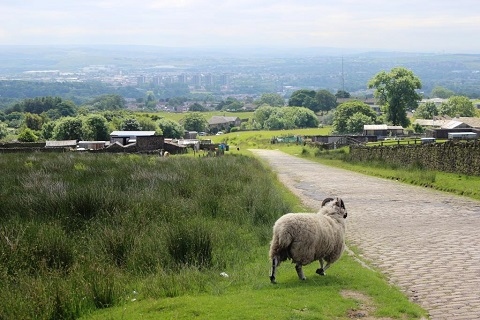Wheels set in motion for gateway to famous Cotton Famine Road to be awarded special conservation status
Date published: 12 July 2017
Residents are being urged to have their say on a new consultation which could see Rochdale’s historic Catley Lane Head area turned into a conservation area.
The rural hamlet, the gateway to Rooley Moor, contains a number of historic buildings, including the grade II listed Smallshaw Farm, which was built in 1622.
It also takes in part of the famous Cotton Famine Road, so-called because Rochdale's cotton workers sided with the African slaves, who picked cotton in the US, in support of President Abraham Lincoln’s pledge to abolish slavery. This was despite the fact that the Union blockade of Confederate ports led to a shortage of cotton supplies coming into Rochdale, causing the ‘cotton famine’ which starved thousands of men and women of their livelihoods.
A public works programme, which included work on the cotton famine road, was created to keep the impoverished cotton mill workers employed during this difficult time.
Conservation area status gives a place special protection in planning law, meaning any application to develop or demolish buildings in the area will need to be considered carefully to ensure it doesn’t damage its historic character.
The recommended conservation area includes Brownhill Farm in the south, the listed Smallshaw Farm in the east and a significant section of Rooley Moor Road, up to Knacks Lane in the north-west and Hunger Hill Farm to the west. The conservation area also includes three ponds, a stream, features such as setted roads and dry stone walls, and a number of vernacular houses.
The council is looking into the option following an approach by the Rooley Moor Neighbourhood Association.
Councillor Daalat Ali, cabinet member or planning and regulation at Rochdale Borough Council, said: “Conservation area legislation is one of the strongest methods available in the planning system to maintain the traditional, special and individual character of a place, so it’s something we are looking into for this wonderfully unique part of the borough.
“This is not about preventing all change, but more about managing development in a way which preserves its special features.”
There are currently 28 conservation areas in the borough, including Littleborough town centre, Birch Village, Toad Lane and Rochdale town centre. The first conservation areas in the country were designated in 1967 and there are now over 8,000 conservation areas in England.
The consultation will run until midnight on 9 August. It can be accessed at: rochdale.gov.uk/consultations and a hard copy will be available at Rochdale Central library in Number One Riverside, Smith Street and Norden Library in Shawfield Lane.
Once the consultation is complete, the results will inform a final appraisal, which will be presented to the Rochdale Township Committee for a decision in October.
Do you have a story for us?
Let us know by emailing news@rochdaleonline.co.uk
All contact will be treated in confidence.
Most Viewed News Stories
- 1Drugs and cash seized during morning raids at suspected stash houses
- 2Middleton school hails another outstanding inspection result
- 3Ogden family announces intention to invest £2m in Rochdale AFC
- 4Former councillor and hospital campaigner Jean Ashworth has died
- 5Man convicted after police car filmed driving dangerously in Kirkholt
To contact the Rochdale Online news desk, email news@rochdaleonline.co.uk or visit our news submission page.
To get the latest news on your desktop or mobile, follow Rochdale Online on Twitter and Facebook.



